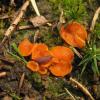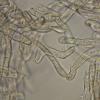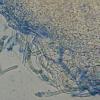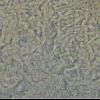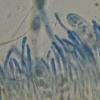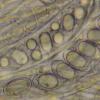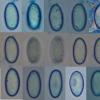
20-12-2025 23:08
Patrice TANCHAUDBonsoir, récolte sur sol sablonneux dans l'arri�

21-12-2025 09:32
Hello.A tiny ascomycete found embedded in wood in

20-12-2025 15:47
Mirek GrycHi.These grew on pine wood that was heavily covere

18-12-2025 21:17
Pol DebaenstThe identification took me to Byssonectria deformi

15-12-2025 07:09
 Danny Newman
Danny Newman
indet. Rutstroemiaceae sp. on unk. fallen leavesMc

19-12-2025 10:10
Patrice TANCHAUDBonjour, récolte réalisée en milieu dunaire, a

18-12-2025 17:23
 Bruno Coué
Bruno Coué
Bonjour,je serais heureux d'avoir votre avis sur c
Neottiella?
Viktorie Halasu,
10-04-2016 12:13
 Hello,
Hello,I got this nice asco and I am not sure if my determination is good:
Apothecia up to 7 mm diam, on soil among mosses in wet forrest, mostly Picea around. I don't know how to recognize from exsiccate if it is bryoparasite or not.
Receptacle is in exsiccate pale orange and visibly hairy.
Hairs ca. 6,6–9,4 ? thick (in LACB), hyaline, thickwalled, obtuse, superficial. Ectal excipulum of t. intricata (probably, didn't see it clearly), medúlla t. intricata.
Asci IKI-, contents colored goldbrown in IKI.
Paraphyses filiform, almost not enlarged at apex, straight or slightly curved.
Spores elipsoid, alive probably with two middle-sized guttules, now mostly one big LB, (18.3) 19.2–20.8 × (9.5) 10–11.3 (11.7) ?. In water they look smooth, but in LACB there's very fine ornamentation of short curved lines, sometimes anastomosing. It's very incomplete, mostly only at poles, or just a few lines across the spore, and I observed it only on some spores. At first, I thought the spores are not ornamented but just wrinkled due to LACB and collapsing.
I think it might be Neottiella aphanodictyon (not completely mature), because of the excipulum structure, hairs and ornamentation. Or is there another (better) match?
Thank you in advance.
Tori
Gilbert MOYNE,
10-04-2016 17:57
Re : Neottiella?
Bonjour,
Oui,il semblerait bien que votre espèce corresponde à Neottiella aphanodictyon = Leucoscypha borealis d'autant que la mousse visible sur la photo semble être une polytrichaceae.
L'espèce est peu courante et les spores sont très finement ornées de lignes formant une sorte de réseau incomplet
Gilbert
Oui,il semblerait bien que votre espèce corresponde à Neottiella aphanodictyon = Leucoscypha borealis d'autant que la mousse visible sur la photo semble être une polytrichaceae.
L'espèce est peu courante et les spores sont très finement ornées de lignes formant une sorte de réseau incomplet
Gilbert
Viktorie Halasu,
11-04-2016 06:38

Re : Neottiella?
Good morning, thank you very much for confirmation.

